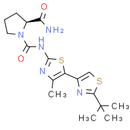Description
A66, CAS No. 1166227-08-2, is a potent and highly selective p110α inhibitor with IC50 of 32 nM in a cell-free assay, >100 fold selectivity for p110α over other class-I PI3K isoforms. A66 blocks phosphoinositide 3-kinase signalling and tumour growth in certain cell types.
Product information
CAS Number: 1166227-08-2
Molecular Weight: 393.53
Formula: C17H23N5O2S2
Synonym:
A66
A 66
A-66
Chemical Name: (S)-N1-(2-(tert-butyl)-4'-methyl-[4,5'-bithiazol]-2'-yl)pyrrolidine-1,2-dicarboxamide
Smiles: CC1N=C(NC(=O)N2CCC[C@H]2C(N)=O)SC=1C1=CSC(=N1)C(C)(C)C
InChiKey: HBPXWEPKNBHKAX-NSHDSACASA-N
InChi: InChI=1S/C17H23N5O2S2/c1-9-12(10-8-25-14(20-10)17(2,3)4)26-15(19-9)21-16(24)22-7-5-6-11(22)13(18)23/h8,11H,5-7H2,1-4H3,(H2,18,23)(H,19,21,24)/t11-/m0/s1
Technical Data
Appearance: Solid Power.
Purity: ≥98% (or refer to the Certificate of Analysis)
Solubility: Soluble in DMSO, not in water
Shipping Condition: Shipped under ambient temperature as non-hazardous chemical or refer to Certificate of Analysis
Storage Condition: Dry, dark and -20 oC for 1 year or refer to the Certificate of Analysis.
Shelf Life: ≥12 months if stored properly.
Stock Solution Storage: 0 - 4 oC for 1 month or refer to the Certificate of Analysis.
Drug Formulation: To be determined.
HS Tariff Code: 382200
How to use
In Vitro:
A66 is a potent inhibitor of the wild-type and oncogenic forms of p110α but not other class-I PI3K isoforms. The p110α-specific inhibitor A66 (0.7 μM) induces a 75-80% reduction in focus formation by the highly transforming iSH2 mutants KS459delN, DKRMNS560del, and K379E. The p110α-specific inhibitor A66 reduced phosphorylation of Akt on T308 by all p85 mutants.
In Vivo:
The optimal dosing strategy for xenograft studies is determined by investigating the drug pharmacokinetics after a dose of 10 mg/kg of body weight by intraperitoneal injection in CD-1 mice. Despite a short half-life of only 0.42 h, the large Cmax (8247 nM) of A66 S that is reached 30 min after dosing ensured that the AUC0-inf (area under the curve from zero time to infinity) (6809 nM•h) is similar to that of BEZ-235 (7333 nM•h), which has a longer half-life of 2.73 h. Furthermore, the A66 on SK-OV-3 tumour tissue is tested using a single dose of 100 mg/kg of body weight to determine whether a long-lasting effect of the drug could be achieved on target tissues. These studies show that A66 causes a profound reduction in the phosphorylation of Akt/PKB and p70 S6 kinase, but not of ERK (extracellular-signal-regulated kinase), at both 1 and 6 h after dosing. Levels of A66 in plasma are determined to be 21.1±1.2 μM and 9.1±1.1 μM at 1 and 6 h after drug injection, whereas levels of A66 in the tumor are 22.7±2.1 μM and 16.0±1.3 μM at the same time points.
References:
- Sweetlove M, Wrightson E, Kolekar S, Rewcastle GW, Baguley BC, Shepherd PR, Jamieson SM. Inhibitors of pan-PI3K Signaling Synergize with BRAF or MEK Inhibitors to Prevent BRAF-Mutant Melanoma Cell Growth. Front Oncol. 2015 Jun 16;5:135. doi: 10.3389/fonc.2015.00135. eCollection 2015. PubMed PMID: 26137449; PubMed Central PMCID: PMC4468830.
- Wang X, Li JP, Yang Y, Ding J, Meng LH. A pharmacological model reveals biased dependency on PI3K isoforms for tumor cell growth. Acta Pharmacol Sin. 2013 Sep;34(9):1201-7. doi: 10.1038/aps.2013.81. Epub 2013 Jul 29. PubMed PMID: 23892273; PubMed Central PMCID: PMC4003165.
Products are for research use only. Not for human use.
Payment & Security
Your payment information is processed securely. We do not store credit card details nor have access to your credit card information.


